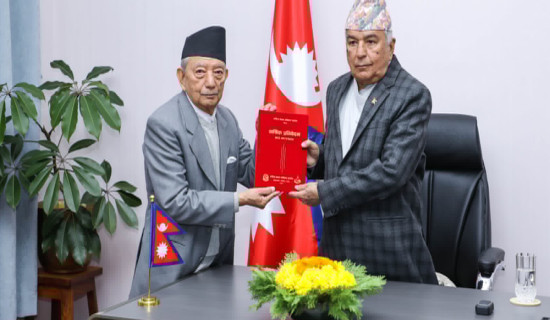- Sunday, 7 December 2025
Watersheds In Nepal’s Foreign Policy
Certain events prove to be watershed in history. So is Nepal’s foreign policy. King Prithivi Narayan Shah laid the foundation of modern and unified Nepal and also charted out basic guidelines for Nepal’s foreign policy. His successors, too, gave continuity to territorial expansion and consolidated the unification process until war broke out between the British colonial power and Nepal in 1814. The Sugauli Treaty was signed between Nepal and imperial Britain in 1816, which not only halted the war but also brought Nepal’s territorial expansion to an end. The Sugauli Treaty was not Nepal’s choice but Nepal was forced to accept it.
The Sugauli Treaty changed the course of Nepal’s overall strategy and also marked another turning point in Nepal’s foreign policy. The Sugauli Treaty conditioned Nepal’s foreign policy, to some extent. However, Nepal, in practice, sought to exercise independent policy in relations with other external forces. The Kot Parba of 1846, through which Junga Bahadur Rana took over power as introduced the Rana family oligarchy that lasted for over a century until it was overthrown by the popular revolt in 1951. The Kot Parva was yet another turning point in the history of Nepal’s political system, governance and foreign policy. It was the time when there was a saying that ‘the sun never sets in the British Empire’, implying that British power was indomitable.
Isolationist policy
The Rana rulers, therefore, sought to maintain their hold on power with iron hands at home while ensuring support from British colonial power. Ranas aligned Nepal’s foreign policy with the British, to a large extent, although they tried to maintain relations with China at a minimum level. The foreign policy during the Rana rule was isolationist. Rana’s isolationist policy, too, was based on the ‘strategy for survival’ as Jung Bahadur took back territories from the British, which had been lost in Sugauli Treaty. However, Rana suddenly awoke and departed from the isolationist policy when the British prepared to withdraw from South Asia, creating two new independent states — India and Pakistan. It was the post-World War II period that saw some new phenomena in international relations and geopolitical dynamics.
The fall of the British Empire, the emergence of the United States as a global power and the rising tide of national liberation movements across the world changed the course of international politics and South Asia’s power dynamics. In the newer regional and international scenario, Ranas tried to readjust Nepal’s policy with that of independent India, while at the same time started diversification in foreign policy. It is with this purpose that Nepal established diplomatic relations with the United States in 1947 and, consecutively with independent India almost two months later in 1947 and with France in 1949.
The year 1947 also marked a watershed in Nepal’s foreign policy. Nepal tried to get UN membership in 1949 but its efforts were thwarted by Russia’s veto. Similarly, the Treaty of Peace and Friendship was reached with independent India in 1950, which is criticised as being unequal one but this treaty has its own diplomatic significance. The 1951 political change heralded a new era not only in politics but also on the foreign policy front. The dawn of democracy opened Nepal to the rest of the world. In 1949, the People’s Republic of China was established.
However, Nepal had not yet established formal diplomatic relations with communist China. There had been divided opinion in the political circle on the issue of establishing diplomatic relations with China. King Tribhuvan and other leaders who rose to power wanted to take the new Indian regime into confidence on the issue related to relations with China. But it was necessary to have relations with China if Nepal wanted to have a balanced foreign policy and come out of the highhandedness of any particular country in foreign policy decision-making.
The year 1955 was thus another landmark in Nepal’s foreign policy history as Nepal finally established diplomatic relations with China on August 1, 1955, which marked a new era of balanced foreign policy conduct of Nepal. Nepal also joined the United Nations in December 1955. In the same year, Nepal participated in the Afro-Asian Conference in Indonesia, known as the Bandung Conference. A new democratically elected government, headed by BP Koirala, was formed in May 1959. The Koirala government emphasised further diversification and innovation of foreign policy.
It was during BP Koirala’s premiership, Nepal established diplomatic relations with Israel, which was a point of departure in foreign policy making Nepal’s marked presence in the global arena and exhibiting its independent foreign policy. Nepal was the first country in South Asia to recognise Israel. By the time BP Koirala’s government was dismissed in December 1960, Nepal had diplomatic relations with 25 countries.
Foreign policy is the domain that always seeks both continuity and change. Continuity pervades more than change in foreign policy conduct and change is effected only when it is necessary. Change is brought about in foreign policy only when variables of national interest change and circumstances demand so. In a general situation, continuity is more often the case in foreign policy. However, the tools and tactics may change depending on the situation and nature of external actors. Nepal’s foreign policy has limited choices given its geographic location and its resultant geopolitical complications.
National interests
Nepal’s foreign policy is characterised more by continuity than change, despite several changes in the political system and governments. Sometimes, interpretation of national interest may vary, which may change foreign policy priorities, its tools and tactics. But generally, national interests are determined by geography, economic variables, cultural factors, values, geopolitical conditions and behaviour and the nature of external actors. Nepal is situated in a unique location between India and China, which are rising powers and rivals.
China is already a global power as it is the world’s second-largest economy and is racing to be number one, superseding the US, while it is also rising phenomenally in terms of military and technological prowess. India is an Asian power and has the ambition of being a global power. The United States is the sole superpower at the moment and has a global presence. Former US President Ronald Reagan once said, ‘Nepal is a neighbour on the other side of the globe,’ implying that America has a meaningful presence in South Asia. Against this backdrop, Nepal has a challenge to navigate its foreign policy and diplomacy in an astute manner on which lies in our national interest.
(The author is a former chief editor of this daily and a former ambassador. lamsalyubanath@gmail.com)















